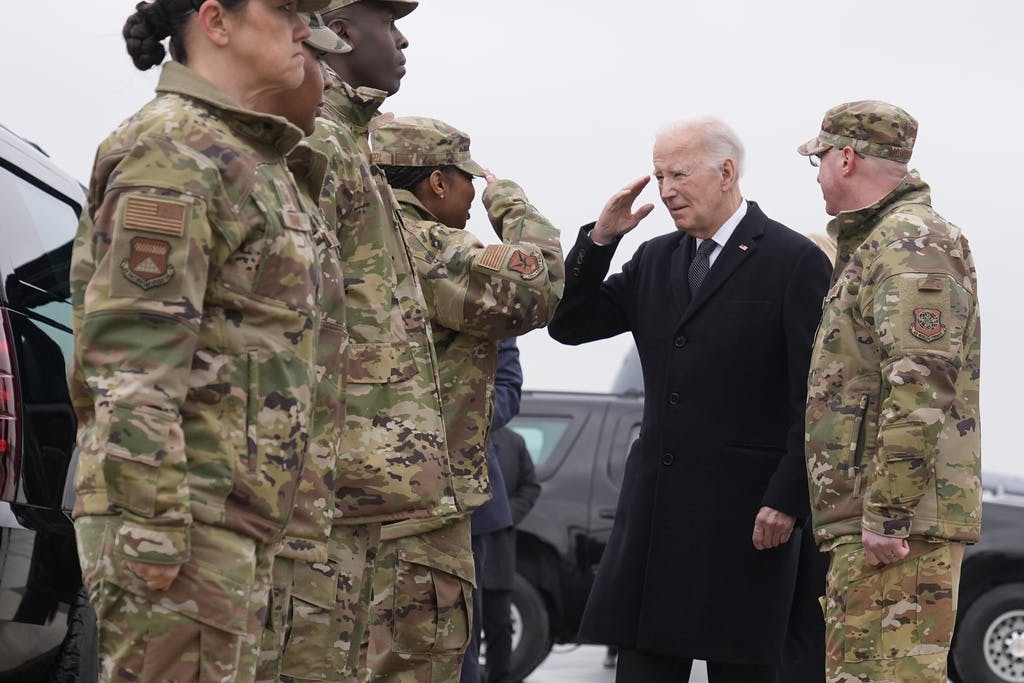America Launches Retaliatory Strikes on Iran-Backed Militias in Iraq, Syria, Officials Say
The strikes by manned and unmanned aircraft hit more than 85 targets, including command and control headquarters, intelligence centers, rockets and missiles, drone and ammunition storage sites and other facilities.

Updated at 5:25 p.m. E.D.T.
WASHINGTON — America’s military launched an air assault on dozens of sites in Iraq and Syria used by Iranian-backed militias and the Iranian Revolutionary Guard Quds force Friday, in the opening salvo of retaliation for the drone strike that killed three American service members in Jordan last weekend, officials said.
President Biden and other top leaders had been warning for days that America would strike back at the militias, and they made it clear it wouldn’t be just one hit but a “tiered response” over time. The officials confirming the initial strikes spoke on condition of anonymity to discuss military operations not yet announced.
The strikes by manned and unmanned aircraft hit more than 85 targets, including command and control headquarters, intelligence centers, rockets and missiles, drone and ammunition storage sites and other facilities.
The Central Command said the strikes used more than 125 precision munitions, and they were delivered by numerous aircraft, including long-range bombers flown from America. One official said B-1 bombers were used.
A Europe-based activist, Omar Abu Layla, who heads the Deir Ezzor 24 media outlet, said the strikes hit areas in east Syria including the countryside of Mayadeen, Quriya and Rahba that is home to a telecommunications center for Iran’s paramilitary Revolutionary Guard and arms depot in Boukamal along the Iraq border.
The assault came just hours after Mr. Biden and top defense leaders joined grieving families to watch as the remains of the three Army Reserve soldiers were returned to America at Dover Air Force Base in Delaware.
It was unclear what the next steps will be, or whether the days of American warnings have sent militia members scattering into hiding, making it more difficult to detect and strike them.
It was evident, though, that the recent statement released by Kataeb Hezbollah, one of the main Iran-backed militias, saying it was suspending attacks on American troops had no impact on the administration’s plans.
The American strikes appeared to stop short of directly targeting Iran or senior leaders of the Revolutionary Guard Quds force within its borders. Iran has denied it was behind the Jordan attack.
In a statement this week, Kataib Hezbollah announced “the suspension of military and security operations against the occupation forces in order to prevent embarrassment to the Iraqi government.”
Harakat al-Nujaba, though, one of the other major Iran-backed groups, vowed Friday to continue military operations against U.S. troops.
America has blamed the Islamic Resistance in Iraq, a broad coalition of Iran-backed militias, for the deadly attack in Jordan, but has not yet narrowed it down to a specific group. Kataeb Hezbollah is, however, a top suspect.
Some of the militias have been a threat to American bases for years, but the groups intensified their assaults in the wake of Israel’s war with Hamas following the October 7 attack on Israel. The war has led to the deaths of thousands of civilians in Gaza and spilled across four other countries now.
Iran-backed militia groups throughout the region have used the conflict to justify striking Israeli or American interests, including threatening civilian commercial ships and American warships with drones or missiles in almost daily exchanges.
Speaking to reporters on Thursday, Secretary Austin said that “this is a dangerous moment in the Middle East.” He added, “We will take all necessary actions to defend the United States, our interests and our people. And we will respond when we choose, where we choose and how we choose.”
“At this point, it’s time to take away even more capability than we’ve taken in the past,” General Austin said.
As of Tuesday, Iran-backed militia groups had launched 166 attacks on American military installations since October 18, including 67 in Iraq, 98 in Syria, and now one in Jordan, according to an American military official. The last attack was January 29 at at al-Asad airbase in Iraq, and there were no injuries or damage.
America, meanwhile, has bolstered defenses at the base in Jordan that was attacked by the Iran-backed militants on Sunday, an official said.
And the Israeli military said its Arrow defense system intercepted a missile that approached the country from the Red Sea, raising suspicion it was launched by Yemen’s Houthi rebels. The rebels did not immediately claim responsibility.
